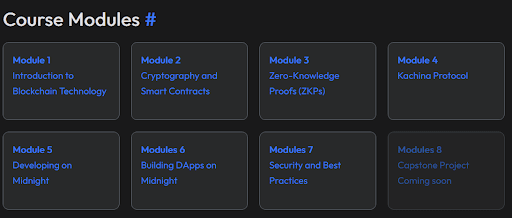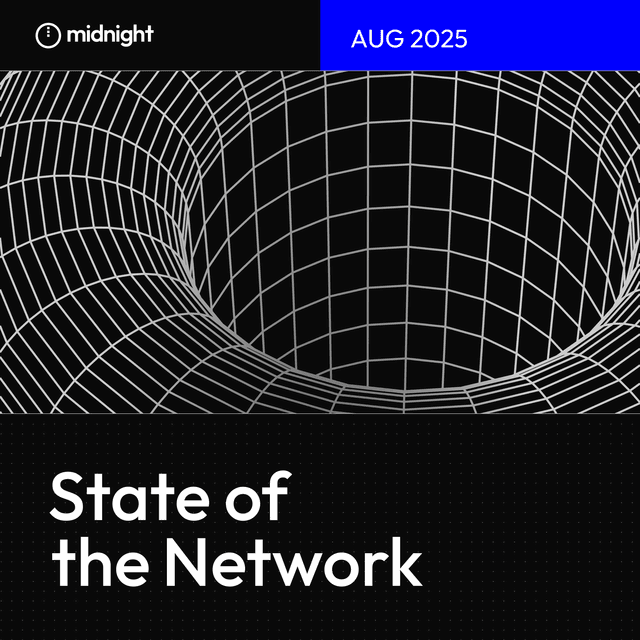Glacier Drop claim portal open
The Glacier Drop claim portal opened on August 5, in advance of Rare Evo, marking a significant milestone in the growth of the Midnight network and expansion of community participation in the run up to mainnet launch.
Glacier Drop is the first phase of the NIGHT token distribution to eligible wallets across eight different ecosystems as a foundation for decentralized growth. This is an initiative that opens up the Midnight ecosystem, and builds a foundation for cooperation and adding value across ecosystems.
Community participation in the Glacier Drop has been a strong start for the distribution. After the first two weeks, claimants have secured over 1.5 billion NIGHT tokens. This figure represents over 6% of the total 24 billion NIGHT tokens available to claim by nearly 34 million eligible wallets.
Find more information in the posts on eligibility requirements and wallet and address compatibility.
Wallet support and claim information
A huge effort has been made to extend support to as many types of wallets and addresses per network as possible in the run up to Glacier Drop. Further work is underway to provide support to additional wallets. Bob Blessing-Hartley, CTO at Shielded, explained the solutions being developed to support the variety of wallets across the supported ecosystems.
The Glacier Drop claim window is open for a full 60 days to ensure every eligible participant has ample and equal opportunity. The claim amount is fixed for the entire duration, meaning the number of NIGHT tokens received is identical whether claimed on the first day or the last. This design provides flexibility, allowing participants to wait for preferred wallet software support or claim at their convenience without any disadvantage.
For a full discussion of the Glacier Drop and what to expect, listen to the replay of this X space with Midnight Foundation President Fahmi Syed, Shielded Technologies CEO Eran Barak and IOHK Founder Charles Hoskinson.
Network pulse
As developers and block producers build up to mainnet launch, this blog will now feature a new section: Network Pulse. Each month, key statistics tracking the health and activity on testnet-02 will be shared, showcasing the network and community metrics from previous months.
As it takes some time to gather these statistics, these will show growth trends across the previous two months. For example, this August update will show changes in network metrics from June to July.
Testnet-02 saw a healthy expansion in both its foundational infrastructure and developer engagement between June and July. The number of valid block producers grew by a significant 30%. This was accompanied by a 23% increase in unique wallet addresses.
Development activity also accelerated:
- Total smart contracts deployed rose by 20%.
- The use of those contracts, measured by total smart contract calls, surged by 42%.
- Faucet requests increased by 5%.
Wallet and custodian ecosystem partners
Blockchain.com, one of the world's most trusted crypto platforms, has integrated support for the Glacier Drop. This allows users of the Blockchain.com wallet to easily check their eligibility and redeem NIGHT tokens directly within their self-custodied wallet, streamlining access for a broad user base across eight major blockchain ecosystems.
To support institutional participation, leading custodians including BitGo, Fireblocks, and Copper will provide secure, institutional-grade custody for NIGHT. This enables their clients to securely claim, store, and interact with NIGHT tokens as part of the Glacier Drop. The involvement of these partners, known for building the standard for institutional digital asset infrastructure, provides the necessary security and framework for large-scale participation in the Midnight network.
Developer education and resources
The ecosystem support is expanding for developers through new community forums, advanced educational modules, and a foundational commitment to open-source development.
Midnight Developer Forums
While the Midnight Discord server is the hub for real-time community interaction, The Midnight Developer Forum has launched to provide a dedicated space for more technical, in-depth and thought-provoking questions in a more formal channel. This platform provides a more structured environment where important questions and detailed conversations are organized, preserved, and easily accessible.
The forum is designed for developers, stake pool operators, MIP authors, and community members and is the best place to get questions answered. Each contribution helps build a lasting public knowledge base, creating long-term value for the entire ecosystem.
Midnight Academy
The Midnight Developer Academy is the launchpad for developers building privacy-preserving applications. Two new advanced modules have now been released, which means the curriculum now contains seven of the eight planned modules, with the latest additions focused on full-stack development and security.
Module 6, Building Full-Stack DApps, covers the end-to-end process of creating and deploying applications using the Compact framework and Midnight.js. Complementing this, Module 7, Security and Best Practices, focuses on the unique security considerations for ZK applications, including data exposure minimization and secure architecture.

These modules precede the launch of the final curriculum piece and the upcoming quest system, which will offer on-chain rewards for applied learning.
Join the Privacy First Challenge
Running from now until September 7, the Midnight Privacy First Challenge invites you to build privacy-enhancing applications and developer tools using zero-knowledge proofs and Midnight's data-protection blockchain. There are two prompts for this challenge and one additional prize category, which means three chances to win. Learn more about the challenge and enter here.
Weekly Fireside Hangs
If you’re a builder, curious about ZK tech or just want to jump in and learn with the DevRel team. Pull up a seat and join the conversation every Wednesday at 15:00 UTC on YouTube.
Shielded joins the Linux Foundation Decentralized Trust
Shielded has become a premier member of the Linux Foundation Decentralized Trust (LFDT), signaling a deep commitment to open-source principles and the future of decentralized development. This move formalizes a strategy centered on open development to make data protection a core component of Web3 infrastructure. Shielded's CTO, Bob Blessing-Hartley, will also join the LFDT Governing Board.
This membership underscores the engineering ethos behind the network. As part of the collaboration, Shielded will support the Midnight Foundation’s contribution of Midnight’s smart contract language, Compact, to the LFDT. Placing this key technology in a neutral home with open governance is a foundational step for future innovation.
Blessing-Hartley stated the goal is to "accelerate the development and enterprise adoption of open-source, privacy-first technologies." He explained that this work will help build "the next generation of internet infrastructure, one that is not only transparent and resilient but also fundamentally respects user privacy."
Releases and documentation
Following the announcement that Shielded is joining the Linux Foundation Decentralized Trust, this month's releases have focused on providing developers with new tools and documentation to build with Compact. The new command-line developer tools simplify the development workflow, while a three-part series of deep-dive articles explains the technical details of the language's compiler and runtime.
New Compact developer tools
A new command-line developer tool, called compact, is now available to standardize toolchain management. The tool automates the installation, updating, and versioning of the Compact compiler and its related components, replacing the previous manual process of managing individual binaries. It replaces the compactc tool as the officially supported way to invoke the compiler. There is also a new Compact code formatting tool.
Developers can use simple commands to switch between compiler versions, check for updates, and invoke the compiler and formatter directly. This tool is the new standard for all developers working with Compact.
- Read the official announcement for installation instructions and a usage guide.
- See the full release notes for version 0.1 and version 0.2.
Compact deep dive part 1: The TypeScript API
The first article in a new technical series examines the output of the Compact compiler, focusing on the TypeScript API generated for every smart contract. This post explains how contract elements like the ledger, circuits, and witnesses are exposed through the API, allowing a DApp to interact with a compiled contract.
It also details the function of the @midnight-ntwrk/compact-runtime package, which provides the necessary types for the DApp to communicate with the contract.
Compact deep dive part 2: circuits and witnesses
The second article in the Compact deep dive series examines the underlying JavaScript implementation of circuits and witnesses. It explains the runtime mechanics, including how proof data is constructed and how the system handles type safety between the contract and the DApp.
This content provides a closer look at the wrapper functions, runtime checks, and data descriptors used to translate dApp calls into verifiable circuit inputs.
Compact deep dive part 3: the on-chain runtime
The third article in the Compact deep dive series explains the role of the on-chain runtime and the Impact VM. It details how a WebAssembly version of the same runtime used by Midnight network nodes is embedded in the DApp. This approach ensures that public ledger state updates have identical semantics when executed locally and when processed on-chain.
This content breaks down the compiled JavaScript to show how Compact operations, such as ledger reads and writes, are translated into instructions for the stack-based Impact VM.
To follow all the latest news and updates across the Midnight Network, join the community on X now.




